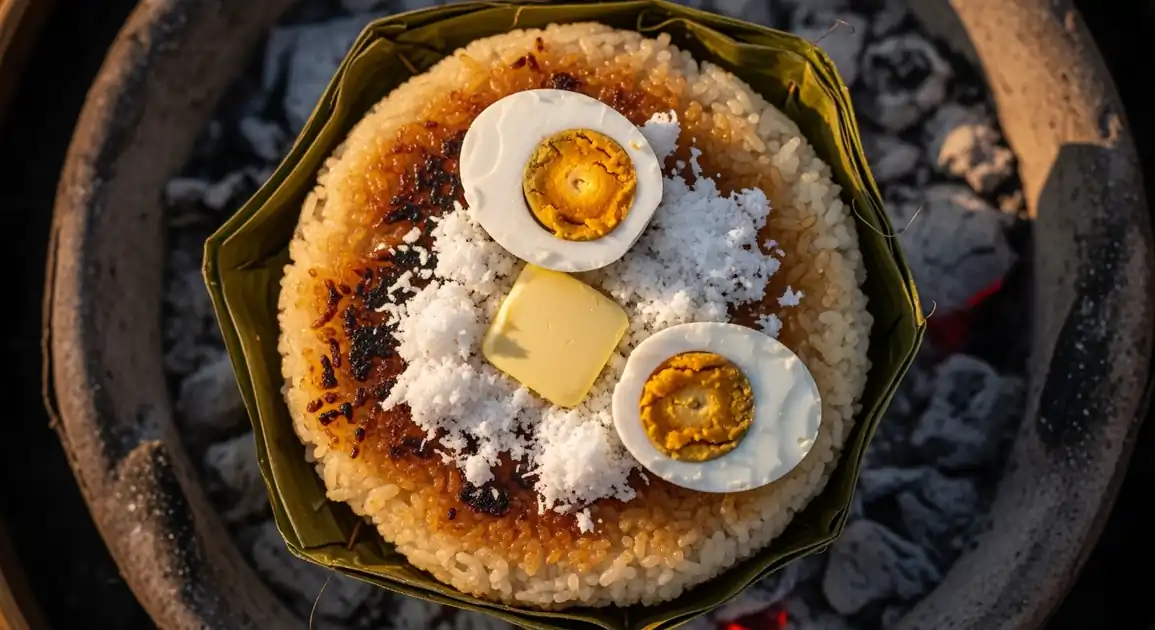Bibingka
Bibingka

Description
Bibingka is enjoyed throughout the Philippines, with particular prominence during the Christmas season's Simbang Gabi (Night Mass) tradition. While regional variations exist, the basic preparation using rice flour, coconut milk, and traditional charcoal cooking in banana leaf-lined clay pots remains consistent across the country.
Dietary Information
Serving information
Serving style
Traditionally served on the banana leaf it was cooked in, often wrapped in paper for takeaway. Eaten while warm, typically by hand. Toppings are added immediately after cooking.
Quick facts
Most bibingka vendors operate from early morning (as early as 4 AM during Christmas season) until supplies last, typically mid-day. In tourist areas, hours extend throughout the day and evening (10 AM - 8 PM).
Safety Tips
What to Look For
-
Clay pots with active charcoal cooking
Traditional clay pot cooking with charcoal ensures proper cooking temperatures that kill potential bacteria.
-
Freshly grated coconut topping
Fresh coconut (rather than pre-grated, stored coconut) indicates attention to quality and reduces spoilage risks.
-
Clean banana leaves
Banana leaves should look fresh and clean, as they come in direct contact with the food.
-
Covered ingredients and toppings
Salted eggs, butter, and other toppings should be covered or refrigerated when not in use, especially in hot weather.
-
Vendors cooking in real-time
Bibingka is best eaten fresh; vendors should be actively cooking rather than having a large pre-made stock.
What to avoid
-
Pre-made bibingka sitting for hours
Bibingka loses both quality and safety when left at ambient temperatures for too long, especially in tropical heat.
-
Vendors with unsanitary conditions
Dirty preparation areas, unwashed hands, or poor food handling practices are red flags.
-
Refrigerated bibingka reheated multiple times
Some vendors reheat leftover bibingka; while not necessarily unsafe, it significantly reduces quality and can introduce safety risks.
-
Discolored or dried-out toppings
Toppings like grated coconut or sliced eggs should look fresh; discoloration suggests they've been sitting out too long.
-
Burnt rather than nicely browned exterior
Extremely blackened bibingka may indicate poor temperature control, which could mean uneven cooking internally.
Price information
Price range
Budget tips
- Simple bibingka from street vendors typically costs 25-50 PHP.
- More elaborate versions with premium toppings or from restaurants can range from 75-120 PHP.
- During Simbang Gabi (Christmas season), prices may increase slightly due to higher demand.
- Markets and local bakeries typically offer better prices than tourist-oriented establishments.
Value indicators
- Size matters - good bibingka should be substantial for the price.
- Quality and quantity of toppings (salted egg, coconut, butter).
- Freshly made using traditional cooking methods.
- Served hot in banana leaf.
- Special toppings or premium ingredients should justify higher prices.
Where to Find This Dish
Markets (Palengke)
Local markets typically have bibingka vendors, especially in the morning hours.
Public Market, Carbon Market
Morning (6 AM - 10 AM), Afternoon
Church Vicinities
Especially during Christmas season, vendors set up near churches before and after mass services.
Basilica, Parish Churches, Cathedrals
Dawn (4 AM - 7 AM during Simbang Gabi), Sunday mornings
Tourist Areas
Popular tourist destinations often have food stalls selling local delicacies including bibingka.
Souvenir shopping areas, Tourist spots, Folk villages
All day, Evening
Vendor Tips
- Ask when it was made or request a freshly made one if possible.
- Morning vendors typically have fresher ingredients and higher turnover.
- Watch the cooking process if possible - it's part of the experience.
How to Order
Regional Variations
-
Classic Bibingka
(Bibingka Special)
The traditional version with salted egg slices, butter, sugar, and grated coconut toppings.
-
Plain Bibingka
(Bibingka Simple)
Without toppings or with minimal toppings, allowing the natural flavor of the coconut rice cake to shine.
-
Cassava Bibingka
(Bibingka Kamoteng Kahoy)
Made with cassava instead of rice flour, particularly common in Bohol and parts of the Visayas.
-
Bibingka with Cheese
(Bibingka con Queso)
Modern variation topped with cheese (usually kesong puti or regular cheese) in addition to or replacing the salted egg.
-
Ube Bibingka
(Bibingka Ube)
Flavored and colored with purple yam (ube), giving it a distinctive purple hue and sweet flavor.
-
Pandan Bibingka
(Bibingka Pandan)
Infused with pandan leaves or flavoring, giving it a green tint and unique fragrance.
-
Mini Bibingka
(Bibingkang Munti)
Smaller versions often sold in sets, sometimes with varied toppings.
Cultural context
History
Bibingka has pre-colonial origins, though its exact beginnings are debated. Some food historians believe it may have Indian or Indonesian influences, as similar rice cakes exist across Southeast Asia. The traditional cooking method using banana leaves and dual heat sources has been practiced for centuries. Bibingka became strongly associated with the Filipino Christmas tradition of Simbang Gabi (Night Mass), where vendors would set up outside churches to serve fresh bibingka to mass-goers. In Cebu and Bohol, it evolved with regional touches while maintaining the core cooking techniques and has become a popular treat for tourists seeking authentic Filipino culinary experiences.
Local significance
Bibingka holds special cultural importance as part of the Filipino Christmas tradition, particularly associated with Simbang Gabi (Night Mass). Successfully completing all nine days of dawn masses is traditionally rewarded with bibingka and other rice cakes.
Eating customs
- Typically eaten while still warm for the best experience.
- The banana leaf wrapper is kept on while eating as it adds aroma and serves as a natural plate.
- Accompanied by hot drinks like salabat (ginger tea) or tsokolate (Filipino hot chocolate).